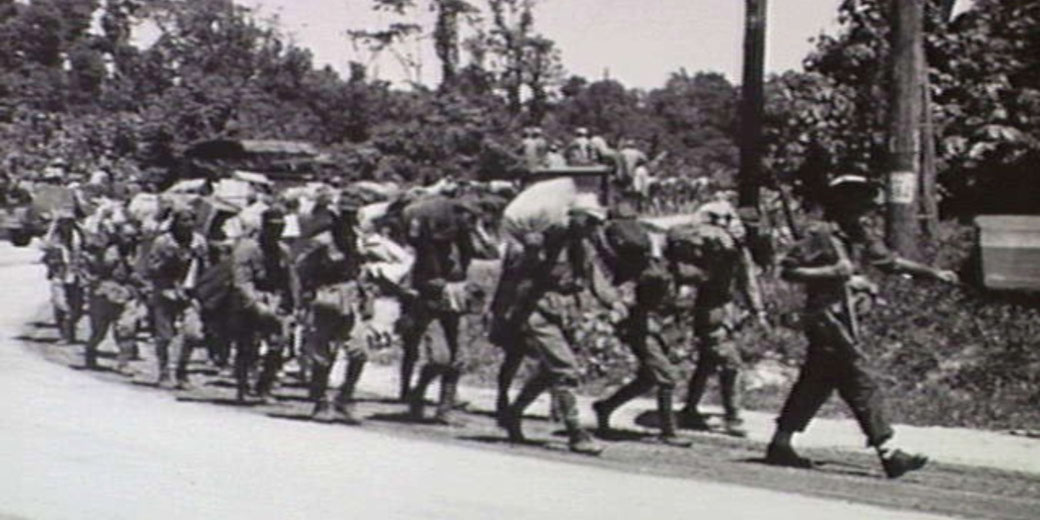The horrors of the Sandakan Death Marches in WWII

The horrific Sandakan Death Marches are one of World War II's most brutal examples of how poorly prisoners of war were treated by their captors.
In the closing years of the conflict, Japanese forces in occupied Borneo forced over 2,400 Allied POWs to endure a series of forced marches through dense jungle.
They would epitomize the extreme cruelty of the Pacific War theater.
Why were there Japanese POW camps in Borneo?
World War II reached the shores of Borneo in 1941 when Japanese forces captured the island in order to control its rich in natural resources.
As the war progressed, the Japanese command in Borneo faced increasing pressure from advancing Allied forces.
Then, the establishment of prisoner of war camps followed, including the notorious Sandakan camp in 1942 on the northeast coast of Borneo.
It initially held British and Australian troops captured in the battles of Singapore and Java.
The prisoners were under the command of Captain Hoshijima Susumi, who subjected them to brutal conditions.
The POWs were also forced to build airstrips and perform other hard labor with minimal food or medical care.
The camp's population swelled to over 2,400 by 1943, as more prisoners were transferred from other facilities.
Overcrowding exacerbated the already dire conditions, leading to rampant disease and starvation.
With this increase in prisoners, the camp's resources were stretched even thinner, further deteriorating the living conditions.
By 1943, the situation for POWs had deteriorated drastically, with rations cut and forced labor increasing amid worsening conditions.
This horrific situation led to a high mortality rate, compounded by the cruel treatment from the guards.
The Death Marches
In January 1945, with the Pacific War turning against Japan, the Japanese military initiated a series of forced marches involving the prisoners of Sandakan.
The intent was to move over 2,400 Allied POWs to the inland village of Ranau, approximately 260 kilometers away, to avoid liberation by advancing Australian forces.
The prisoners, already weakened by malnutrition and abuse, were forced to walk through dense, malaria-infested jungles.
Among these movements were the infamous death marches, which began in January 1945.
The first march consisted of 455 prisoners. Although it only took them nine days to complete the journey, they were only provided rations for only four days.
At various points along the way, those who could no longer walk were often executed on the spot, their bodies left unburied beside the trail.
By the time they reached Ranau, about half of the prisoners died en route or were killed when they could no longer continue.
By the time of the second and third marches later in the spring, few were left fit enough to attempt the journey.
The second march began on 29 May 1945 with around 536 prisoners. This time, it took 26 days and once more, were provided with less food than they needed.
Only about 180 prisoners survived by the time they arrived on 24 June 1945. The third and final march, on the 9th of June, involved 325 people who had practically no food at all supplied to them.
The prisoners were so sick and malnourished that all of them had died by the time they had walked 50 km.
As a result, the casualties and losses from the Sandakan Death Marches are among the most staggering of World War II's Pacific Theater.
For those left behind at the Sandakan camp, survival was equally unlikely as supplies continued to dwindle and the guards grew more brutal.
At the end of the war, the camp was almost completely destroyed. Of the approximately 2,400 Allied POWs who began the marches from Sandakan to Ranau, only six Australians survived until the war's end.
How do we know about these events?
Among the notable figures in the camp were Lieutenant-Colonel William Sticpewich and Major Rod Wells, who documented their experiences and helped orchestrate a series of secret diaries detailing daily life and the atrocities committed.
These diaries were crucial for post-war tribunals.
Owen Campbell, one of the few who survived, recounted the extreme cruelty and unbearable conditions they endured during the forced marches.
He described how fellow prisoners, too weak to continue, were mercilessly killed or left to die in the dense jungle.
Through his vivid recollections, Campbell conveyed the despair and faint glimmers of hope that kept some going despite the overwhelming odds.
In his interviews post-war, he emphasized the resilience and close friendship among the prisoners, which, for some, made the difference between life and death.
The testimonies of survivors like Campbell and others were later used in war crimes trials to bring Japanese commanders to justice.
Nelson Short, another survivor, provided detailed descriptions of the march routes and the specific locations where atrocities occurred.
His detailed memory helped to corroborate the collective narrative of the survivors, ensuring that the ordeal they went through was officially recorded and recognized.
This horrific moment in WWII history shows that human rights violations have long-lasting effects on peoples and societies.
The brutal reality faced by the POWs at Sandakan reminds us of the need for stringent war regulations and the humane treatment of all individuals, regardless of the circumstances.
What do you need help with?
Download ready-to-use digital learning resources
Copyright © History Skills 2014-2025.
Contact via email
With the exception of links to external sites, some historical sources and extracts from specific publications, all content on this website is copyrighted by History Skills. This content may not be copied, republished or redistributed without written permission from the website creator. Please use the Contact page to obtain relevant permission.





